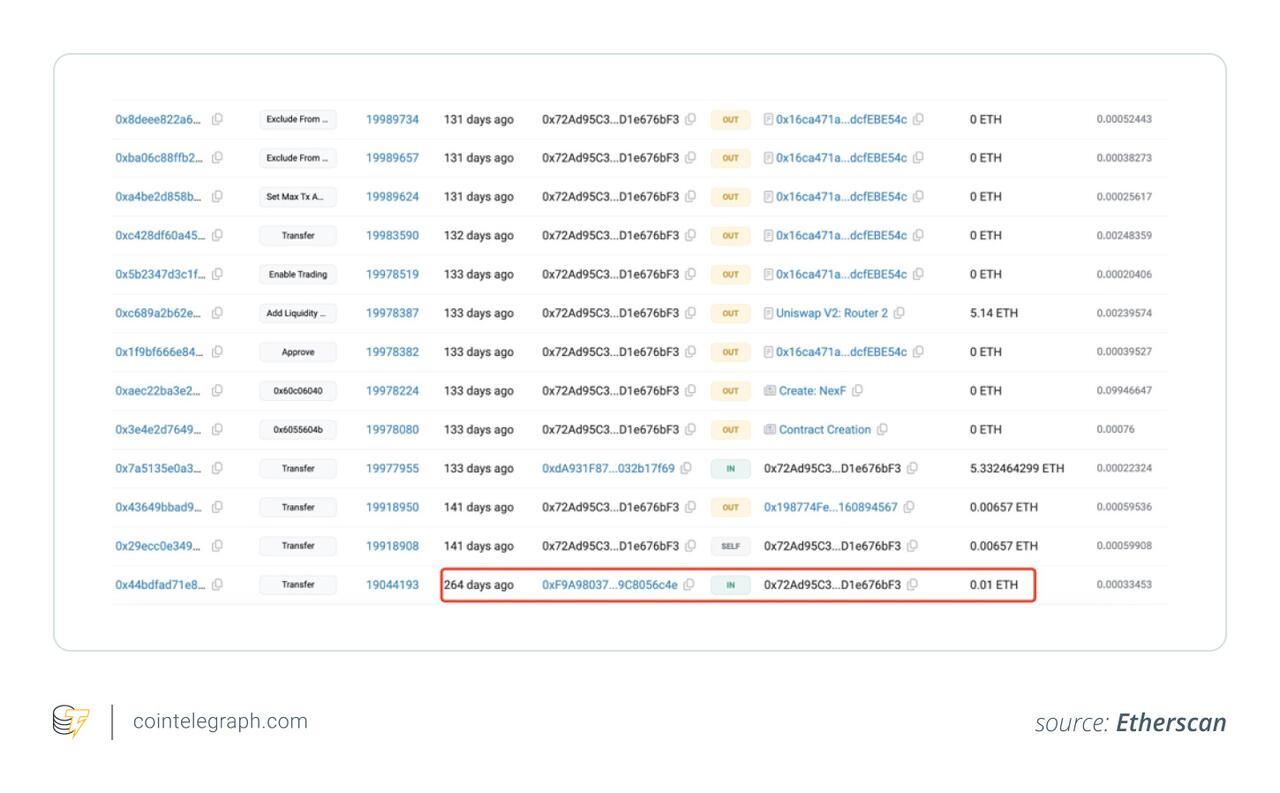NexFundAI: The FBI's 'Trap Token' Explained
Authored by Bradley Peak via CoinTelegraph.com,
What is NexFundAI, the FBI’s crypto trap?
NexFundAI, introduced by the US FBI in May 2024, is an Ethereum-based crypto token created as part of a covert sting operation, Operation Token Mirrors.
The NexFundAI token was designed to act as bait, targeting individuals and organizations engaged in fraudulent cryptocurrency activities, particularly pump-and-dump schemes. In these scams, manipulators artificially inflate a token’s value, attracting unsuspecting investors, only to dump their holdings once the price peaks, leaving investors with losses.
NexFundAI mimicked the look and behavior of a legitimate cryptocurrency, allowing the United States Federal Bureau of Investigation to attract market manipulators. Fraudsters were lured into engaging with the token, performing illegal actions like wash trading, where multiple trades are conducted by the same party to create a false impression of trading volume. This tactic inflates the token’s value and deceives investors into thinking there’s a growing demand.
In the end, NexFundAI helped the FBI collect hard evidence against 18 individuals and implicated companies like Gotbit and ZM Quant, who were involved in orchestrating sham trades across more than 60 crypto tokens. By July 2024, the FBI had built a case strong enough to file charges, leading to the arrests of key figures in these schemes.
Did you know? Over $25 million in assets were seized as a result of the NexFundAI sting, and the investigation helped reveal new methods scammers were using to manipulate crypto markets.
The evolution of crypto sting operations
Crypto sting operations evolved from traditional physical setups to sophisticated digital stings, with the FBI leveraging blockchain monitoring and targeting scams like Silk Road, Ponzi schemes and initial coin offering (ICO) fraud since the rise of Bitcoin in the early 2010s.
In the early days of financial crime enforcement, agents would pose as buyers, investors or intermediaries to catch criminals in the act, often involving wire transfers or cash. As technology advanced, cybercrime emerged, shifting the focus of sting operations from physical cash to digital assets.
This shift began in earnest with the rise of Bitcoin in the early 2010s, which introduced a new form of untraceable, decentralized digital currency. Criminals quickly adopted crypto for money laundering, scams and hacks.
The FBI responded with its first major crypto sting operations targeting online black markets like Silk Road in 2013, which relied on Bitcoin BTC$68,139 for illegal transactions. These early efforts revealed the potential for digital stings, where law enforcement could monitor blockchain transactions in real-time.
As crypto crime grew, so did the scope of sting operations. One of the notable examples was Operation Phish Phry in the late 2000s, targeting online hackers.
But it wasn’t until the 2010s that law enforcement focused more heavily on crypto scams, such as Ponzi schemes and hacking rings. Operation Cryptosweep in 2018 marked a major effort, targeting over 200 ICO scams that defrauded investors worldwide. Law enforcement agencies in the US and Canada coordinated to crack down on fraudulent ICOs, recovering millions of dollars in stolen funds.
Similarly, the FBI’s involvement in catching Ponzi schemes like the Bitconnect fraud in 2018 showcased how digital stings could expose major crypto crimes.
Did you know? In the cryptocurrency world, one of the largest digital stings was Operation Silk Road, which targeted the illegal online marketplace Silk Road in 2013. The operation resulted in the arrest of Ross Ulbricht, the site’s founder, and the seizure of millions of dollars in Bitcoin.
How the FBI used NexFundAI to expose crypto fraud
Appearing legitimate, complete with a website, branding and tokenomics, the NexFundAI token attracted market manipulators, including firms specializing in wash trading and pump-and-dump schemes.
NexFundAI was set up as a typical Ethereum-based token, complete with a website, branding and tokenomics that looked no different from any legitimate crypto project. The FBI made sure that NexFundAI had all the elements necessary to attract the attention of manipulators — an active online presence, attractive prospects and, most importantly, a sense of legitimacy. By creating a facade of authenticity, the FBI was able to trick market makers into thinking this token had the potential for huge profits.
To further strengthen the bait, the FBI engaged with market-making firms that specialized in manipulating prices. These firms often perform wash trading and pump-and-dump schemes to inflate token prices artificially. NexFundAI provided an ideal playground for these manipulators to demonstrate their fraudulent tactics, all under the close watch of law enforcement.
By mimicking how real crypto projects operate, the FBI effectively created a “honey pot,” luring these firms into fraudulent activities without realizing they were being watched.
Once the market manipulators started interacting with NexFundAI, the FBI was able to gather evidence in real-time. As noted, companies like Gotbit and ZM Quant, who had a history of inflating trading volumes through sham trades, were caught in the act, much like flies in a honeypot.
Also, onchain data reveals that a wallet, which once manipulated SAITAMA to rake in over $11 million, funded the NexFundAI deployer with just 0.01 Ether ETH$2,642.12. The wallet spent $7,300 to buy 875.8 trillion SAITAMA, sold 687.66 trillion for $8.85 million, and deposited 737 trillion ($2.75 million) into OKX and Gate.io. And after buying back with $253,000, this single wallet profited over $11 million from SAITAMA.
Wash trading, which involves making trades between accounts controlled by the same party to create the illusion of liquidity, was one of the key fraudulent activities observed. These trades mislead investors into thinking the token is in high demand, driving up its price before the manipulators dump their holdings for profit.
The FBI closely tracked the token’s trading activity and recorded the fraudulent trades, ensuring they had solid evidence of manipulation. This wasn’t just limited to market activity; the FBI also gathered digital communications, contracts and payment records from the firms involved.
The operation revealed just how coordinated these frauds were. In addition to wash trading, the FBI identified price manipulation techniques, including deliberately timing large purchases and sales to influence market sentiment. Through NexFundAI, the FBI not only observed fraud but also directly participated in the market-making process, recording every move the fraudsters made.
Did you know? One of the largest wash trading indecents in history involved BitForex, which in 2019 was found to have 95% of its trading volume attributed to wash trading, as reported by blockchain transparency projects. This type of artificial volume manipulation affected billions of dollars in trading, misleading investors about the actual market demand.
NexFundAI: Fighting fire with fire
NexFundAI has proven itself in the fight against crypto fraud as a successful tactic in exposing bad actors.
By creating its own token, the FBI was able to gain a unique insider’s perspective by observing fraudulent activities from within the very system criminals sought to exploit. Instead of merely tracking transactions from the outside, as in previous operations, the FBI became a player in the crypto world.
The success of Operation Token Mirrors could have long-lasting implications for how law enforcement operates in the crypto space. The operation demonstrated that creating undercover tokens and projects could become a powerful tool to unmask crypto criminals. As fraudsters grow increasingly sophisticated, operations like these offer a way to infiltrate their schemes directly, rather than just monitoring them from the sidelines.
This strategy could make scammers and market manipulators more cautious in the future, as they will no longer know if the token they’re manipulating is part of an FBI sting. It adds a new layer of unpredictability to the already volatile crypto market. Fraudsters may hesitate to engage in blatant market manipulation, knowing that law enforcement could be watching — and even participating — in their activities.
Additionally, this operation sets a precedent for future digital stings. Law enforcement agencies worldwide could adopt similar strategies, creating their own tokens to track criminal behavior. This kind of proactive approach signals a new era in crypto enforcement, where fraud detection becomes more about participation and less about passive observation.
How to spot a trap token
If anything seems off — whether it’s unrealistic promises, hidden team members or unexplained market activity — it’s worth reconsidering your involvement. NexFundAI proves that even the most legitimate-looking tokens can be traps designed to exploit unsuspecting investors.
Being able to spot trap tokens is crucial because they’re often designed to attract investments through pump-and-dump schemes. These tokens might look like they represent legitimate projects, sometimes backed by large investments or sudden price jumps, making you want to invest quickly.
Of course, law enforcement uses trap tokens like NexFundAI to catch bad actors, not genuine investors. But whether it’s a trap token created by law enforcement or a scam set up by bad actors, falling for these schemes can lead to huge losses. You risk losing your entire investment if you don’t spot the warning signs in time.
Here are some general red flags for you to be aware of:
Sudden price spikes without clear fundamentals: One of the clearest signs of a potential scam or trap token is rapid price increases without any real-world news or project development to support the rise. Pump-and-dump schemes often follow this pattern, where manipulators drive up the price to lure investors before selling off their holdings and crashing the market. If a token’s value skyrockets overnight with no clear reason, it’s a red flag.
Low liquidity paired with high volumes: Another telltale sign is when a token shows unusually high trading volumes, but the liquidity — the ease with which assets can be bought or sold — remains low. This can indicate wash trading, where the same entity is buying and selling the token repeatedly to create the illusion of activity. If the token seems difficult to trade or withdraw, that’s another warning sign.
Presence of wash trading: Look out for patterns that suggest wash trading, like a high number of trades happening in quick succession or very small price movements between trades. Wash trades artificially boost the appearance of demand, misleading investors into thinking there’s more interest in the token than there really is. Tools like blockchain explorers or specialized sites that track suspicious trading activity can help you spot these patterns.
Lack of transparency: Be wary of projects that aren’t upfront about their team, technology or development goals. Fraudulent tokens often hide behind anonymity or vague promises. Legitimate projects typically have clear, transparent roadmaps, active developer communities and accessible teams.
Lastly, before investing in any token, check for regulatory warnings and verify the legitimacy of the project. Entities like the US Securities and Exchange Commission or equivalent bodies in other countries often issue warnings about known scams and fraudulent projects. These advisories are designed to protect investors from getting involved in shady operations. You can also use public tools and databases, such as the SEC’s EDGAR database, to verify whether the token has been flagged as fraudulent or involved in a legal dispute.
More crypto stories on ZeroHedge

Ether ETF Staking Could Come As Soon As May

ECB Exec Renews Push For Digital Euro To Counter US Stablecoin Growth

The Gold Standard Is Back - Stablecoins Need To Rethink What 'Backing' Really Means
NEVER MISS THE NEWS THAT MATTERS MOST
ZEROHEDGE DIRECTLY TO YOUR INBOX
Receive a daily recap featuring a curated list of must-read stories.






